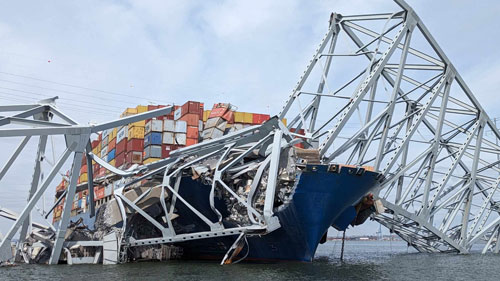
Credit: U.S. Army Corps of Engineers, Baltimore District
On March 26, 2024, the 984-foot container ship DALI (IMO 9697428) collided with the Francis Scott Key (I-695) Bridge. During the incident the bridge collapsed in the Patapsco River. Debris from the accident blocked large vessel traffic, resulting in a closure of Baltimore Harbor.
The DALI departed the Port of Baltimore around 12:45 am. As the ship neared the bridge, it appeared to loose electrical power briefly.
The vessel made a MAY DAY call and moments later struck a large support on the west side of the channel. The main bridge structure immediately collapsed into the river and onto the bow of the ship.
Within minutes, emergency response to the accident began. An immediate closure of the bridge before the collision by emergency responders likely saved lives.
On the water, vessels from the U.S. Coast Guard, Baltimore City Fire Department, U.S. Army Corps of Engineers (USACE), Baltimore District, local tugboats, and others responded quickly and began search and rescue efforts and other support.
Coast Guard watchstanders received a report into the Coast Guard Sector Maryland – National Capital Region command center at 1:27 a.m. reporting a Singapore-flagged containership collided with the Francis Scott Key Bridge.
Additionally, it was reported that the bridge collapsed and there were reports of persons in the water. Response boat crews from Coast Guard Stations Curtis Bay and Annapolis deployed to the incident for active search and rescue.
By approximately 9 am, Baltimore Mayor Brandon M. Scott had issued an Executive Order declaring a State of Emergency in Baltimore City in response to the Francis Scott Key Bridge collapse incident.
Maryland Governor Wes Moore declared a State of Emergency in Maryland and announced that the state was working with an interagency team to quickly deploy federal resources.
As a result of the accident, I-695 Outer Loop closed at MD 10 (exit 2) and Inner Loop closed at MD 157/Peninsula Expressway (exit 43), according to Maryland Transportation Authority (MDTA).
Also on March 26, the U.S. Army Corps of Engineers (USACE), Baltimore District activated its Emergency Operations Center, clearing the way for more than 1,100 engineering, construction, contracting and operations specialists to provide support to local, state and federal agencies following the collapse of the bridge.
In accordance with USACE’s federal authorities, USACE will lead the effort to clear the Federal channel as part of the larger interagency recovery effort. Together with local, state, and federal partners, they are working closely to determine the key actions required to remove the fallen bridge.
USACE, Baltimore District operates and maintains more than 290 miles of federal navigable channels within the Susquehanna River watershed, including the Fort McHenry Channel where the bridge is located.
On Wednesday March 27th, a Unified Command and Joint Information Center was established in Baltimore to coordinate response and disseminate information for the Francis Scott Key Bridge collapse.
The Key Bridge Response 2024 Unified Command includes the:
U.S. Coast Guard
U.S. Army Corps of Engineers
Maryland Department of the Environment
Maryland Transportation Authority
Witt O’Brien’s representing Synergy Marine
Maryland State Police
A website with incident response information can be found at the following URL:
https://www.keybridgeresponse2024.com
The Unified Command’s operational priorities are ensuring the safety of the public and first responders, accountability of missing persons, protecting the environment, incident stabilization, safely restoring transportation infrastructure and commerce, and supporting the investigation.
Following the collision, a safety zone was established for all navigable waters of the Chesapeake Bay within a 2,000-yard radius of the Francis Scott Key Bridge.
The safety zone is intended to protect personnel, vessels, and the marine environment in these navigable waters.
To seek permission to enter the safety zone boaters must ONLY use Marine Band Radio VHF–FM channel 16 (156.8 MHz).
Those in the safety zone must comply with all lawful orders or directions given to them by the COTP or the COTP’s designated representative.
The U.S. Coast Guard may be assisted in the patrol and enforcement of the safety zone by Federal, State, and local agencies.
As salvage operations progressed, access to Fort McHenry channel has increased, with several temporary channels being implemented.
Residents mourn those lost in the tragedy. On March 27th, two bodies were recovered from the collapse site. A third body was recovered on April 5th. On April 14th, a forth body was recovered from the site. The 5th body was recovered on May 1st and the final body was recovered on May 7th.
The Francis Scott Key Bridge is one of Baltimore’s most familiar landmarks. Located on I-695 (Baltimore Beltway), the bridge spans the lower Patapsco River between Hawkins Point and Sollers Point. The bridge is the outermost of the three major crossings of Baltimore Harbor.
Managed by the Maryland Port Administration, Port of Baltimore’s state-owned public marine terminals and private terminals handled a record 52.3 million tons of foreign cargo, worth $80 billion, in 2023.
More Information
Port of Baltimore Temporary Alternate Channel
Port of Baltimore FSK Bridge Wreckage Removal Efforts
M/V Dali Collision – Francis Scott Key Bridge Collapse NTSB Investigation
2 Responses